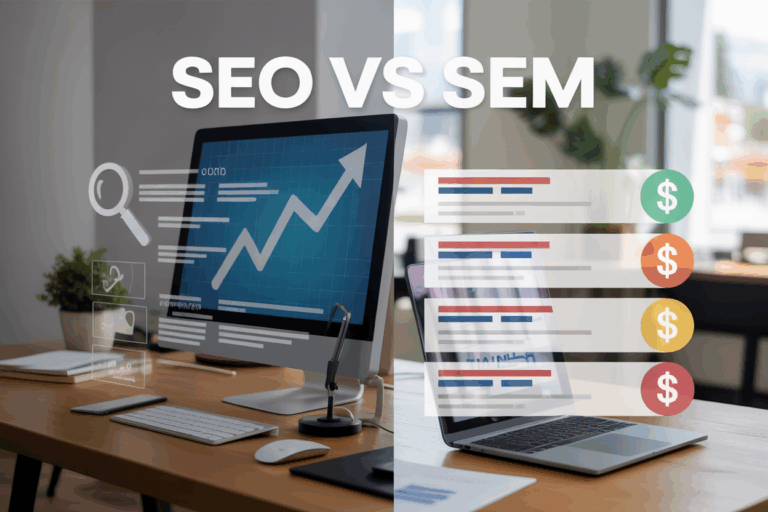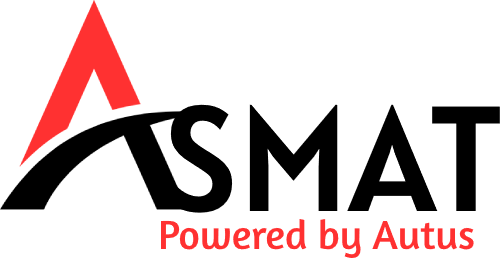
Digital marketing can feel overwhelming when trying to decode the differences between SEO and SEM. These two search marketing strategies often get confused, yet each serves distinct purposes in driving website traffic and business growth.
This beginner SEO guide targets business owners, marketing professionals, and entrepreneurs who need clarity on search engine optimization basics versus search engine marketing approaches. Understanding SEO vs SEM helps businesses make informed decisions about where to invest their marketing budget and resources.
The following sections will break down the core differences between paid advertising vs organic search methods. First, explore how SEO builds long-term website visibility through organic ranking strategies and content optimization. Next, discover how SEM delivers immediate results through paid search campaigns and targeted advertising.
The guide will also examine the cost structures of each approach, comparing upfront investments with long-term returns. Finally, learn how timeline expectations differ dramatically between these digital marketing strategies, helping determine which method aligns best with specific business objectives and available resources.
Understanding SEO Fundamentals for Better Website Visibility
How SEO Drives Organic Traffic to Your Website
Search engine optimization functions as the bridge between website content and potential visitors actively searching for relevant information. When someone types a query into Google, Bing, or other search engines, SEO ensures websites appear prominently in the unpaid search results. This organic visibility drives qualified traffic without paying for each click, making it a cost-effective long-term strategy.
The magic happens through content optimization and technical improvements that help search engines understand and rank web pages. Unlike paid advertising, organic traffic continues flowing even when marketing budgets tighten. Users typically trust organic results more than paid advertisements, leading to higher click-through rates and better engagement metrics.
Effective SEO strategies target specific keywords that align with user intent, ensuring the right audience discovers relevant content at the perfect moment in their search journey. This targeted approach creates a sustainable traffic source that grows stronger over time as search engines recognize the website’s authority and relevance.
Key SEO Elements That Search Engines Evaluate
Search engines examine numerous factors when determining page rankings, creating a complex ecosystem of ranking signals. Content quality stands as the primary consideration, with search algorithms favoring comprehensive, original, and valuable information that addresses user queries effectively.
Technical SEO elements play an equally important role in search engine evaluation. Page loading speed, mobile responsiveness, and secure HTTPS connections directly impact user experience and rankings. Search engines prioritize websites that provide seamless browsing experiences across all devices.
On-page optimization elements include strategic keyword placement, meta descriptions, title tags, and header structure. These components help search engines understand content context and relevance. Additionally, internal linking architecture guides search engine crawlers through website content while distributing authority between pages.
Off-page factors, particularly high-quality backlinks from authoritative websites, signal trustworthiness and expertise to search engines. Social signals and user engagement metrics also influence rankings, though their direct impact varies across different search algorithms.
Understanding what is SEO? provides deeper insights into these fundamental ranking factors and their practical applications.
Long-term Benefits of Investing in SEO Strategies
SEO investments compound over time, creating sustainable competitive advantages that paid advertising cannot replicate. While initial results may take months to materialize, the long-term benefits justify the patience and consistent effort required for success.
Cost efficiency represents one of the most compelling advantages of SEO strategies. Once organic rankings improve, traffic continues flowing without ongoing per-click costs. This creates predictable, scalable growth that supports business expansion without proportional marketing expense increases.
Brand credibility strengthens as websites climb search rankings, establishing authority within specific industries or niches. Higher search visibility translates to increased brand awareness, with users naturally associating top-ranking websites with industry leadership and expertise.
The cumulative effect of SEO efforts creates barriers for competitors attempting to overtake established rankings. Market dominance becomes increasingly difficult to challenge as websites build comprehensive content libraries, earn quality backlinks, and develop strong technical foundations.
SEO strategies adapt to changing consumer behaviors and search patterns, providing resilience against market fluctuations. This flexibility allows businesses to pivot content strategies while maintaining their organic search presence, ensuring continued visibility during economic uncertainties or industry shifts.
Exploring SEM Components and Paid Advertising Advantages
How SEM Delivers Immediate Traffic Through Paid Ads
Search engine marketing provides businesses with instant visibility through paid advertising placements. Unlike organic search strategies that require months to show results, SEM campaigns can generate clicks and conversions within hours of launch. These paid ads appear prominently at the top of search engine results pages, capturing immediate attention from users actively searching for relevant products or services.
The immediate nature of SEM makes it particularly valuable for time-sensitive promotions, product launches, or seasonal campaigns. Businesses can adjust their ad spend, targeting parameters, and messaging in real-time based on performance data, allowing for rapid optimization and improved results.
Popular SEM Platforms and Their Unique Features
Google Ads dominates the SEM landscape, offering extensive reach across Google’s search network and partner sites. The platform provides sophisticated targeting options, including location-based advertising, demographic filtering, and keyword match types. Google Shopping campaigns specifically benefit e-commerce businesses by showcasing product images and prices directly in search results.
Microsoft Advertising (formerly Bing Ads) captures a significant portion of search traffic, particularly among older demographics and business professionals. The platform often delivers lower cost-per-click rates compared to Google Ads while maintaining quality traffic.
Social media platforms like Facebook Ads and LinkedIn Ads extend SEM beyond traditional search engines, enabling businesses to target users based on interests, behaviors, and professional attributes. These platforms excel at building brand awareness and reaching audiences who may not actively search for specific products.
Budgeting Strategies for Effective SEM Campaigns
Successful SEM campaigns require strategic budget allocation across different campaign types and objectives. Starting with a conservative daily budget allows businesses to test market response before scaling investments. The 80/20 rule proves effective: allocating 80% of budget to proven, high-performing campaigns while dedicating 20% to testing new keywords, ad formats, or targeting options.
Bid strategies significantly impact budget efficiency. Manual bidding provides complete control but requires constant monitoring, while automated bidding strategies like Target CPA (Cost Per Acquisition) or Target ROAS (Return on Ad Spend) optimize for specific business objectives.
Geographic and temporal budget distribution maximizes campaign effectiveness. Concentrating spend during peak business hours and in high-converting locations ensures budget allocation aligns with customer behavior patterns.
Measuring SEM Performance and Return on Investment
Key performance indicators for SEM campaigns extend beyond simple click counts. Click-through rate (CTR) indicates ad relevance and appeal, while Quality Score affects both ad positioning and cost efficiency. Conversion tracking reveals which keywords and ads generate actual business value, not just website traffic.
Cost metrics provide critical insights into campaign profitability. Cost-per-click (CPC) shows immediate expense levels, while cost-per-acquisition (CPA) reveals the true cost of gaining new customers. Return on ad spend (ROAS) calculations determine whether SEM investments generate positive returns.
Attribution modeling helps businesses understand the customer journey across multiple touchpoints. First-click attribution credits the initial interaction, while last-click attribution focuses on the final conversion trigger. Multi-touch attribution provides a more comprehensive view of how different SEM components contribute to overall marketing success.
Regular performance analysis enables continuous optimization. Weekly reviews of search term reports identify negative keywords to exclude, while monthly trend analysis reveals seasonal patterns and growth opportunities.
Comparing SEO and SEM Cost Structures
Why SEO Requires Upfront Investment with Delayed Returns
Search engine optimization demands significant initial investment without immediate financial returns. Businesses must allocate resources for content creation, website optimization, technical improvements, and ongoing maintenance before seeing tangible results. This front-loaded investment model differs dramatically from traditional advertising approaches.
The upfront costs include hiring SEO specialists, purchasing optimization tools, conducting comprehensive website audits, and developing high-quality content. Many companies also invest in redesigning websites to meet search engine requirements, which can represent substantial expenditure. These initial investments typically span several months before generating measurable traffic increases.
The delayed return nature of SEO stems from search engines’ gradual indexing and ranking processes. Google and other search engines require time to crawl, evaluate, and rank optimized content. Building domain authority and establishing trust signals takes consistent effort over extended periods. This timeline often discourages businesses seeking immediate results, despite SEO’s long-term benefits for sustainable growth.
How SEM Costs Scale with Your Advertising Budget
Search engine marketing operates on a pay-per-action model where costs directly correlate with advertising spend. Businesses can start with modest budgets and scale campaigns based on performance metrics and available resources. This flexibility makes SEM accessible to companies regardless of size.
Cost-per-click rates vary significantly across industries, keywords, and competition levels. Highly competitive terms in lucrative sectors like finance or insurance command premium prices, while niche markets often offer more affordable entry points. Campaign budgets can range from hundreds to thousands of dollars monthly, depending on target reach and conversion goals.
SEM platforms provide granular budget control, allowing advertisers to set daily spending limits, pause campaigns instantly, and adjust bids in real-time. This immediate control enables businesses to respond quickly to market changes, seasonal demands, or budget constraints. The scalable nature of SEM costs makes it particularly attractive for businesses testing new markets or products.
Hidden Costs in Both SEO and SEM Strategies
Beyond obvious expenses, both SEO and SEM strategies carry hidden costs that significantly impact overall investment requirements. These overlooked expenses often catch businesses unprepared and can substantially increase marketing budgets.
SEO Hidden Costs:
- Ongoing content creation and updates
- Technical maintenance and website security
- Analytics tools and monitoring software
- Link building and outreach campaigns
- Regular algorithm adaptation efforts
SEM Hidden Costs:
- Landing page design and optimization
- Ad creative development and testing
- Campaign management time and expertise
- Conversion tracking setup and maintenance
- Competitive analysis and market research
Both strategies require continuous optimization efforts that demand skilled professionals or extensive learning curves. SEO demands staying current with algorithm updates, while SEM requires constant bid management and ad performance monitoring. The time investment for managing either strategy internally often exceeds initial estimates, leading many businesses to hire specialized agencies or consultants.
Quality assurance represents another hidden cost factor. SEO requires regular content audits and technical reviews, while SEM demands ongoing ad quality assessments and landing page improvements. These quality control measures ensure optimal performance but require dedicated resources that businesses often underestimate during initial planning phases.
Timeline Differences Between SEO and SEM Results
Why SEO Takes Months to Show Significant Results
SEO operates on a fundamentally different timeline compared to paid advertising methods. Search engines need time to discover, crawl, and index new content before evaluating its relevance and authority. Google’s algorithm considers hundreds of ranking factors, including content quality, backlink profiles, and user engagement metrics, which require substantial data collection periods to assess accurately.
Building organic authority doesn’t happen overnight. New websites typically experience what experts call the “sandbox effect,” where search engines temporarily limit visibility while evaluating legitimacy. Even established sites face delays when implementing new SEO strategies, as search engines need 3-6 months to recognize and reward optimization efforts.
The complexity of modern SEO compounds these delays. Quality content creation, technical optimization, and natural link building all require consistent effort over extended periods. What is SEO? fundamentals emphasize that sustainable rankings depend on proving long-term value to users rather than quick fixes.
How SEM Can Generate Traffic Within Hours
SEM timeline results operate on an entirely different scale. Pay-per-click campaigns can begin driving traffic within minutes of activation, assuming proper account setup and approval processes. Search engines prioritize paid advertisements in prominent positions, bypassing the lengthy evaluation periods required for organic content.
The immediate nature of SEM stems from its auction-based system. Advertisers bid on keywords, and winning ads appear instantly in search results. Campaign optimization happens in real-time, allowing marketers to adjust targeting, budgets, and messaging based on immediate performance data.
Ad platforms provide instant feedback through comprehensive analytics, enabling rapid testing and refinement. Unlike SEO efforts that require months to evaluate effectiveness, SEM campaigns can be assessed and optimized within hours or days of launch.
Planning Your Marketing Timeline for Both Approaches
Strategic digital marketing requires understanding both immediate and long-term objectives. SEM serves as an excellent bridge during the early months of SEO implementation, providing immediate visibility while organic efforts mature. This dual approach prevents the revenue gaps that often occur when relying solely on SEO for new websites or campaigns.
Budget allocation should reflect these different timelines. SEM requires ongoing investment to maintain visibility, while SEO demands upfront investment in content and optimization with longer-term payoffs. Planning cycles should account for SEO’s 6-12 month maturation period alongside SEM’s immediate but ongoing costs.
Seasonal considerations also impact timeline planning. E-commerce businesses might increase SEM spending during peak shopping periods while using quieter seasons to focus on SEO foundation building.
Balancing Quick Wins with Long-term Growth
The most effective SEO vs SEM strategies combine both approaches strategically rather than viewing them as competing alternatives. SEM provides immediate market insights and customer data that can inform SEO content strategies, while SEO builds the sustainable foundation that reduces long-term advertising dependency.
Quick wins through SEM can fund longer-term SEO investments by generating immediate revenue and market validation. This revenue can support content creation, technical improvements, and link building efforts that drive organic growth.
Smart marketers use SEM data to identify high-converting keywords for SEO targeting, essentially using paid campaigns as research tools for organic optimization. This integration maximizes the value of both immediate SEM results and long-term SEO benefits, creating a comprehensive search marketing approach that delivers both immediate results and sustainable growth.
Choosing the Right Strategy for Your Business Goals
When SEO Makes More Sense for Your Budget
SEO becomes the logical choice when working with limited marketing budgets and seeking sustainable growth. Small businesses often find better value in organic search strategies since they don’t require ongoing ad spend once momentum builds. The initial investment focuses primarily on content creation, technical optimization, and maybe some professional guidance.
Budget-conscious organizations benefit from SEO’s compound effect – each piece of optimized content continues attracting visitors without additional costs. This makes perfect sense for service providers, local businesses, or companies with products that solve specific problems people actively search for online.
Long-term thinkers particularly appreciate SEO’s cost structure. While the upfront work demands time and effort, the payoff extends months or years beyond the initial investment. Educational content, how-to guides, and informational resources perform exceptionally well in organic search, making SEO ideal for businesses that can create valuable content around their expertise.
Situations Where SEM Delivers Better ROI
SEM shines when immediate visibility becomes critical for business success. E-commerce stores launching new products, seasonal businesses, or companies entering competitive markets often see better returns from paid advertising campaigns.
Time-sensitive promotions demand SEM’s instant results. Black Friday sales, holiday campaigns, or limited-time offers can’t wait for organic rankings to develop. The ability to turn traffic on and off like a faucet makes paid advertising invaluable for these scenarios.
Highly competitive industries where organic rankings prove nearly impossible to achieve also benefit from SEM strategies. Legal services, insurance, and finance sectors often require significant budgets to compete organically, making targeted paid campaigns more efficient.
Local businesses targeting specific geographic areas frequently discover that local search ads provide immediate visibility while their organic presence develops. Understanding what is SEO? helps businesses recognize when paid alternatives might serve their immediate needs better.
How to Combine SEO and SEM for Maximum Impact
The most successful digital marketing strategies blend both approaches strategically. Smart businesses use SEM data to inform their SEO keyword targeting, testing which terms convert best through paid campaigns before investing in long-term optimization efforts.
SEM provides immediate coverage for high-value keywords while SEO efforts develop in the background. This dual approach ensures continuous visibility during the months-long process of building organic authority.
Remarketing campaigns work exceptionally well when combined with organic content marketing. Visitors who discover a website through organic search but don’t convert immediately can be retargeted with specific ads, increasing overall conversion rates.
Seasonal businesses often run paid campaigns during peak periods while focusing SEO efforts on building year-round organic presence. This strategy maximizes revenue during busy seasons while developing sustainable traffic sources for slower periods.
Common Mistakes to Avoid When Starting Out
New marketers frequently make the mistake of viewing SEO vs SEM as an either-or decision rather than complementary strategies. This narrow thinking limits potential results and wastes opportunities for synergy between both approaches.
Expecting immediate results from SEO ranks among the most common errors. SEO requires patience – typically 3-6 months before significant improvements become visible. Abandoning efforts too early prevents businesses from realizing the long-term benefits of organic search optimization.
Conversely, many businesses rely too heavily on paid advertising without building organic foundations. This creates expensive dependency on ad spend and vulnerability to budget cuts or platform changes.
Poor keyword research affects both SEO and SEM success. Starting campaigns or optimization efforts without understanding what audiences actually search for leads to wasted resources and disappointing results. Taking time to research search behavior patterns prevents costly targeting mistakes.
Ignoring mobile optimization represents another critical oversight. Since mobile searches now dominate desktop queries, both organic and paid strategies must prioritize mobile user experience to achieve meaningful results in today’s digital marketing landscape.
SEO and SEM each offer distinct advantages that can transform how businesses connect with their target audience online. SEO builds long-term organic visibility through content optimization and technical improvements, while SEM delivers immediate results through paid advertising campaigns. The choice between them often comes down to budget constraints, timeline expectations, and specific business objectives.
Smart businesses don’t have to pick just one approach. Combining SEO’s sustainable growth with SEM’s instant visibility creates a powerful digital marketing strategy that covers both immediate needs and future success. Start by assessing current business goals, available resources, and desired timelines to determine the right mix of organic and paid search efforts that will drive meaningful results.






